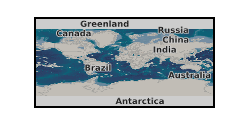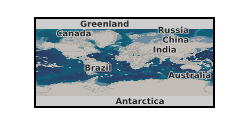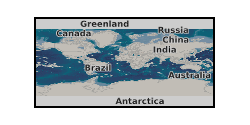Carbon cycle
Type of resources
Topics
Keywords
Contact for the resource
Provided by
Years
Formats
Update frequencies
-

Global warming during the Palaeocene-Eocene Thermal Maximum (PETM, ~56 Ma) is commonly interpreted as being driven by massive destabilization of carbon from surficial sedimentary reservoirs. If correct, this has important implications for the amplification of future fossil fuel emissions via carbon-climate feedbacks. In our study we provided new paired records of boron and carbon isotope changes in the ocean that questions this long-held interpretation. Our data are implemented in an Earth system model to reconstruct the unfolding carbon cycle dynamics across the event. Strong evidence for a larger (>10,000 PgC) and on average isotopically heavier (> -17‰) carbon source leads us to identify volcanism associated with the North Atlantic Igneous Province as the main driver of the PETM. We also find that although organic carbon feedbacks with climate played a more minor role in driving the event than previously thought, organic matter burial was important in ultimately sequestering this carbon and driving the recovery of the system. Data presented in this data set comprise geochemical elemental, as well as boron, carbon and oxygen isotopic data from surface dwelling foraminifera Morozovella Subbotina. Alongside the boron isotopic data we also provide reconstructed surface water pH with corresponding uncertainties for our preferred pH reconstruction.
-

The global carbon cycle - how much carbon is stored in its interconnected reservoirs (ocean, atmosphere, plants and soils on land, sediments in the deep sea) as well as the fluxes between them, is not set in stone. We know from the geological record that the concentration of CO2 in the atmosphere has varied enormously over the last few hundred million years. The chemistry of the oceans also gradually changes with time and the organisms living within it adjust and evolve. As a result, how the carbon cycle 'works', and particularly, how well (or not) atmospheric CO2 (and hence climate) is regulated in the face of disruption, also changes on geological time-scales. This creates challenges to understanding the causes and consequences of past global warming like events and how such events can be related to potential future changes. Sediments slowly accumulating in the deep ocean reflect what goes on around and above them, both chemically and biologically. Of particular interest to us is the mineral calcium carbonate (CaCO3), which can be found in the form of chalk and limestone rocks today. CaCO3 is used by certain marine organisms for constructing shells and skeletons. Hence, the amount of CaCO3 that in buried in sediments tells us something about ancient organisms and ecosystems. In addition, CaCO3 will start dissolving in seawater if the conditions too are acidic or the depth (and thus pressure) too great. How much CaCO3 originally created by organisms at the surface that escapes dissolution in sediments below to be buried and preserved in the geological record can thus tell us something about the chemistry, depth, and when data from many locations is available, the circulation of the ocean in the past. Looking for subtle changes in the composition of ancient mud in the hundreds and hundreds of meters of sediment core recovered from the ocean floor by drill ship would be a little like looking for a needle in a haystack. However, Nature has been kind to us and the transition from white-colored sediments rich in the carbonate shells of dead marine organisms to clays devoid of carbonate is easy to spot. This point represents a fine balance between the amount of shell material being deposited to the sediments and the rate of dissolution of these shells. Hence, this reflects a certain relationship between surface ocean biological processes and deep ocean chemistry and circulation. Any change in these factors will drive sediments rich in CaCO3 or devoid of any trace of carbonate secreting organisms. In this project we will compile the records from many hundreds of different sediment cores that have been recovered since the 1960s. Will identify the 'balance point' in these cores (if one exists) and combine all the confirmation to reconstruct how this balance point has changed in depth and time in the different ocean basins. Because the age of the sediments in some cores extends back to well before the white cliffs of Dover were deposited, we will start our record there. The interpretation of our curve will not be entirely straightforward, because multiple environmental influences all push and pull the balance point in different directions and with different strengths. We will therefore also use a computer model representation of the Earth's climate and oceans, its carbon cycle, ocean chemistry, and the composition of sediments in the deep sea. We will use this model to explore how the different aspects of the global carbon cycle affect the balance point, and by comparing model predictions to our new curve, interpret how the carbon cycling and the sensitivity of atmospheric pCO2 (and hence climate) to being perturbed by massive greenhouse gas release, has changed over the past 150 million years. Hence we will not only be able to answer the question: do we live in a particularly 'lucky' or 'unlucky' time in terms of how sensitive our global environment is burning fossil fuels, but we will know why.
-

Geochemical and isotopic data presented here cover the Paleocene-Eocene Thermal Maximum (~56 Ma ago) and were produced to assess the degree of carbon cycle perturbations, ocean acidification and the origin of the emitted carbon added to the atmosphere-ocean system during this major carbon cycle perturbation event. For further details on the analytical approach please refer to the original publication (Gutjahr et al., 2017, Nature). Data contained within the two tables comprise foraminiferal carbonate based stable boron, carbon and oxygen isotopic results from DSDP Site 401 located within the Bay of Biscaye in the NE Atlantic (Table 1). This table also contains B/Ca, Mg/Ca and Al/Ca data from the same samples. Depth in core is presented alongside two alternative relative age models setting ages in relation to the Carbon Isotope Excursion observed during the Paleocene Eocene Thermal Maximum. Table 2 contains high-resolution bulk carbonate stable carbon and oxygen isotopic results that were produced to establish a new age models for this core.
-

Three Published Papers; Thomson et al CMP 2014 - Origin of Sub-Lithospheric diamonds from the Juina-5 Kimberlite (Brazil): constraints from Carbon Isotopes and Inclusion Compositions http://dx.doi.org/10.1007/s00410-014-1081-8. Thomson et al Nature 2016 - Slab melting as a barrier to deep carbon subduction http://dx.doi.org/10.1038/nature16174 Burnham et al 2015 - Stable Isotope evidence for Crustal Recycling as recorded by superdeep Diamonds http://dx.doi.org/10.1016/j.epsl.2015.10.023 NERC grant abstract: Natural diamonds are formed at high pressures and temperatures deep within the Earth's interior. When diamonds form, probably from carbonate-rich fluids and melts in the mantle, they sometimes encapsulate small pieces of the minerals that occur at great depth in the Earth. These are called mineral inclusions. The diamonds are then transported from Earth's deep mantle to the surface in uncommon magmas called kimberlites. Diamonds that contain these mineral inclusions are very rare, and offer a truly unique glimpse into what is an otherwise inaccessible portion of the Earth. Some very rare inclusions provide direct samples of lithologies present in the mantle transition zone (400 - 660 km) and the lower mantle (>660 km) - these are often called superdeep diamonds. The chemistry of the inclusions along with mineral phase relations yield important information about the kinds of lithologies they originated in, and constrain the conditions of diamond formation and the depth at which kimberlite magmas form. Thus, superdeep diamonds are very important for studying the types of materials that occur in the deep Earth, for elucidating deep mantle processes, and for understanding how carbon is cycled from the surface to the mantle and back to the surface again - the deep carbon cycle. For example, some diamonds contain materials that are very similar to those occurring near the earth's surface, such as minerals akin to oceanic crust or sediments, and these often have carbon isotopic compositions akin to organic carbon - although this is a controversial subject. From this, we can conclude that surface materials can be transported to great depth, helping to constrain models of mass transfer in Earth by mantle convection. Further, by dating when the diamonds formed, for example by dating of inclusions, we can effectively place time constraints in the geodynamic processes involved in diamond formation and uplift in the mantle. Inclusion-bearing diamonds suitable for study are very hard to come by. We are very fortunate to be in possession of several large suites (over 200 inclusion-bearing diamonds in all!) of diamonds from kimberlite pipes in the famous Juina region of Brazil, a region known for its superdeep diamonds. Our previous study on diamonds from the Juina region has yielded some fascinating results, and has led to a model of material recycling beneath Brazil that we have recently published in the journal Nature and in Contributions to Mineralogy and Petrology. We now wish to extend our investigations by studying new suites of diamonds from Juina to test our current model, and to make high-pressure temperature experiments that will allow us to determine at what depths the inclusions formed and equilibrated, and will provide information needed to constrain the rates at which diamonds were transported in the solid-state mantle, possibly in a mantle plume. Here, we propose a three-year project for a comprehensive mineralogical, geochemical, isotopic and experimental investigation of these unique diamonds and their mineral inclusions.
-

The dataset consists of eleven spreadsheet tabs, each tab containing lipid biomarker palaeothermometry (air temperature reconstructions) and bulk organic carbon isotope data from individual lignites that are known to stratigraphically span the Cretaceous-Palaeogene (K-Pg) boundary. Uncalibrated, raw biomarker distributions (glycerol dialkyl glycerol tetraethers; GDGTs) are provided, as well as the calculated calibration outputs. Site coordinates are: West Bijou, Colorado (39°34'14'N, 104°18'09'W), Sussex, Wyoming (43°39'40"N, 106°19'06"W), Pyramid Butte, North Dakota (46°25'03'N, 103°58'33'W), Hell Creek Road, Montana (47°31'35"N, 106°56'23"W), Rock Creek West, Saskatchewan (49°02'20"N, 106°34'00"W), Wood Mountain Creek, Saskatchewan (49°25'20"N, 106°19'50"W), Frenchman Valley, Saskatchewan (49°20’56"N, 108°25’05"W), Knudesn’s Coulee, Alberta (51°54’27"N, 113°02’57"W) Griffith’s Farm, Alberta (51°54’47"N, 112°57’51"W), Coal Valley Cores (GSC CV-42-2, Cores 1 and 2), Alberta (53°05’02"N, 116°47’ 40"W) Police Island, Northwest Territories (64°52'42"N, 125°12'33"W).
 NERC Data Catalogue Service
NERC Data Catalogue Service